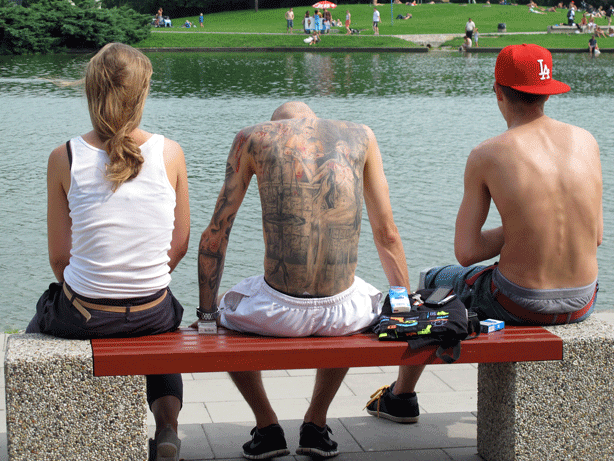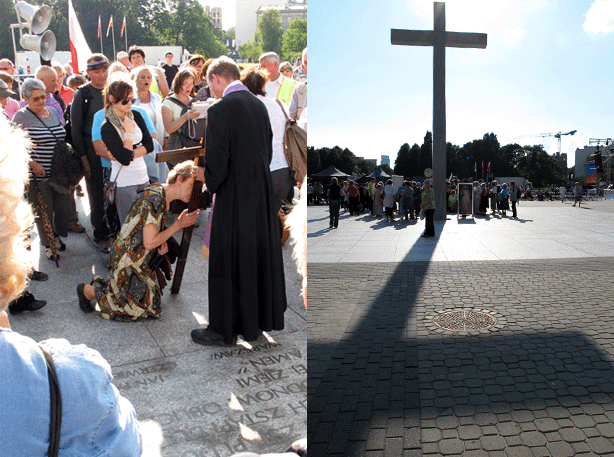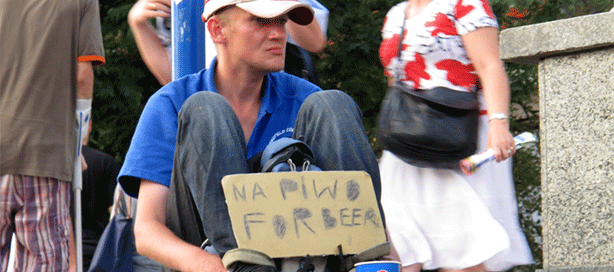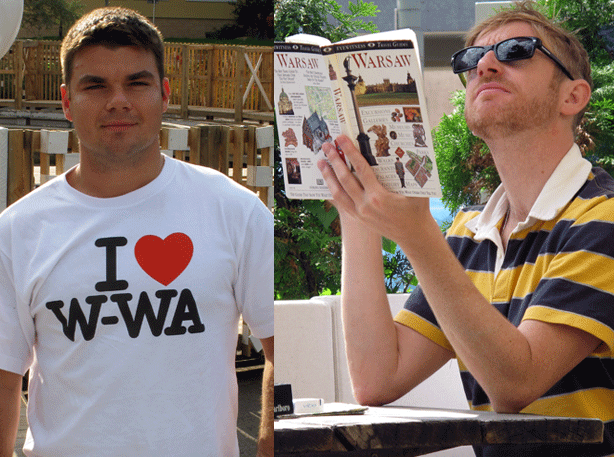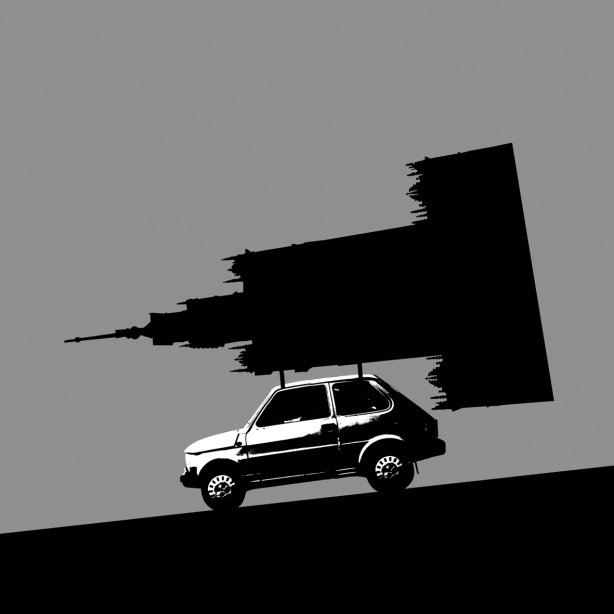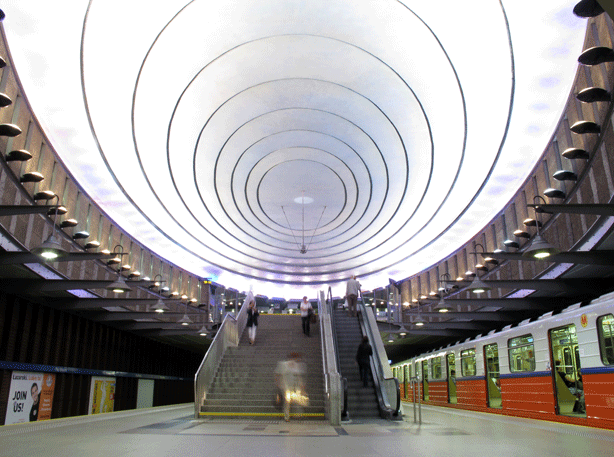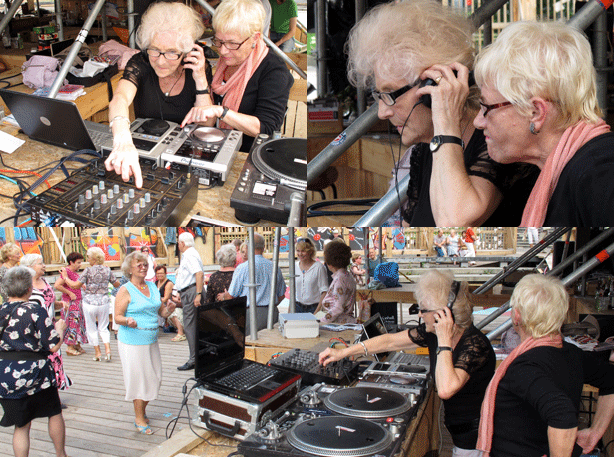Postscript
Posted: 31 August, 2011 in History, Miscellaneous, People, ReligionTags: anti-Semitic, catholic, Euro Cup, piwo, Radio Maryja, smoking, Varsovians, Warsaw
A few last reflections on overtime on some of the differences between Warsaw and Stockholm, Varsovians & Stockholmers…
To begin with the obvious: the difference in living standards, cost of living, price level, housing etc. Sweden, not without reason, is considered as a role model for the welfare state, with its well-functioning social safety net (incl. five weeks a year of – paid – holiday). Of course this doesn’t come gratis, heavy taxation is the price. Most Swedes do lead a very comfortable life. In Poland one can’t avoid noticing that people really work hard to make ends meet while striving for a better life and it’s not that unusual to have more than one job.
Another major difference between Sweden and Poland is their past. While Swedes neither know nor care about its country’s yesteryear – Sweden has neither been occupied nor at war for more than 200 years – history is very much alive among the Poles, in particular WW II causing the Holocaust and the destruction of Warsaw, followed by almost half a century of Soviet communist occupation.
Which brings me to religion. While Sweden probably is the most secular (Christian) country on earth the Poles may well be the most die-hard Catholics in the world, a human force with decisive domestic political implications which makes for a complicated decision-making. A political situation in part taken advantage of by unpleasant right-wing fanatic elements (e.g. the anti-Semitic Radio Maryja).
Except for native Poles there’s one easy recognizable demographic group, the Vietnamese, the largest ethnic minority, making up 1% of the total population. Very few come from the Middle East and (North) Africa as opposed to Sweden, which due to its very generous and liberal immigration laws has evolved into much more of a multicultural society, though not without plentiful of integration difficulties.
Anyway, being a visitor to Warsaw is quite a pleasant experience; people you meet, e.g. in shops and (as in my case) new neighbours greet you with a Dzien dobry, Good day, a kind of everyday politeness that went out of style a long time ago in Stockholm. The Varsovians have a much more of a people friendly attitude which makes for a less snooty and a warmer environment in general.
Streets, pavements, public transport, not to mention parks in Warsaw are tidy, its inhabitants (except for many a dog owner) refrain from littering. Not so in Stockholm, where the locals contrary dispose of their trash where they stand or on the go; caffè latte mugs, bottles, cans, ice cream wrappings and – most common of all droppings: their used endemic snus (“snuff”). A perfectly normal and accepted(?) behaviour in a country where the population seem to have switched their tobacco/nicotine addiction, from suction to gum bags (observe the bulky upper lip).
Cigarettes still rule in Warsaw though… Everybody smokes, especially the young! Particularly noticeable at open-air cafés, where the open air is substituted by fume.
From one vice to another: drinking. A traditional culture shared by both Poles and Swedes. Preferentially beer (and vodka) and where the aim often is just to get drunk. A discipline that younger Poles master considerately better than their Swedish equals, who usually tend to be pissed already early in the (Friday/Saturday) evening only to get loud and (too) often into brawls. A rather surprising observance I must admit, having imagined that the availability of “Alcohol 24 hours” and the (comparatively) inexpensiveness in Poland would come with more “side effects”. Binge drinking among the local football supporters of Stockholm and Warsaw (Legia/Polonia) and the element of older (homeless?) winos (/beeros?) on the street benches seem however to be more on par. Although the Swedes (and Swedish Finns…) are more aggressively acting out.
Toilets (for men) in cafés, bars and clubs in Sweden are as a rule a disgusting destination for the needy – potty training is obviously another neglected art when using a public lavatory. Fortunately the Varsovians do not have the same urge to soil.
Fashion… is not overly recognizable on the streets of Warsaw, and definitely not so for men. In Stockholm, home of H&M consensus, there is more awareness and people are generally much better dressed (though not that individually).
And almost everybody speaks fairly good English, certainly among ages 20-45. Remarkably few Poles do, at least among the people I’ve met. Perhaps time to limit the dubbing of foreign TV series and films?
As earlier mentioned and posted, Warsaw is a pretty rundown town. Stockholm is not, only pretty. It takes pride of its water, Lake Mälaren, while Warsaw unintelligibly is turned away from the Wisła River. Just imagine some future beach life in the heart of the city!
What Euro Cup 2012 will bring to Warsaw – except for the grand new National Stadium in white and red – remains of course to be seen but it will inevitability be a boost for the emerging new spirit of the city and its inhabitants!
Well, all that said I’ll close this blog by throwing in some mixed leftover pics by yours WaWaBeginner.
Bis: Do widzenia!
Do widzenia Warszawa!
Posted: 27 August, 2011 in Art, History, SightsTags: Karolina Breguła, Little One, Maluch, Palace of Culture and Science, Pałac Kultury i Nauki, PKiN, Polski Fiat 126p, Rudnev
Well, it was inevitably bound to happen, alas, but the time has come for me to say goodbye to Warsaw and return home to my regular (radio) life in Stockholm. My month-long summer stay is coming to an end and thus it’s time to close this blog (my first!). A project I’ve enjoyed doing and to my delight has caught much more attention than I had expected. And the fact that my scattered “outsider” impressions have received so many followers among the insiders, you inhabitants of Warsaw, is especially surprising – and rewarding. Dzięki (thanks) to you all for support and Lubię to!
I thought I’d end with this WaWaBeginner blog with this spot-on Warsaw work by visual artist Karolina Breguła, an illustration combining two iconic relics of the old Communist era: The Palace of Culture and Science and “The Little One”.
Smack in the centre of town stands the city’s most visible landmark, The Palace of Culture and Science (Pałac Kultury i Nauki, PKiN), the tallest building in Poland (231 m high/42 floors). Loved by tourists and less so (read detested) by (a large number of) the Varsovians. The palace, designed by the Soviet architect Lev Rudnev, was completed 1955. Joseph Stalin offered it as “a gift from the Soviet nation to the Polish people” – yet paid for by the Poles themselves.
Nicknamed Maluch, “The Little One”, Polski Fiat 126p came to symbolize freedom and modern lifestyle under the communist regime; 3 millions of them were produced in Poland from 1973-2000. Despite its very small size, it was the first popular and affordable car to motorize ordinary families. Further more it came to be regarded as a cherished family member, most probably because they had to wait years to actually get to own one.
Well, those were the days… And although some old habits clearly die hard a new Warsaw (and Poland) is emerging rapidly. An exciting evolution which I certainly hope to be back to take – a further viewing – part in.
Na razie, Warszawa!
Bread spread
Posted: 24 August, 2011 in Food&DrinkTags: bread, cebule, chleb, cholesterol, lard, piwo, pork fat, schmaltz, skwarki, smalec
Smalec is a type of Polish lard created from rendered pork fat. Homemade smalec is typically imbued with pork cracklings (skwarki), chopped and fried onion (cebule). It is a classic peasant dish typically used as a substitute for the ‘rich man’s butter’ and is smeared (thickly) on bread (chleb) . It may not qualify as a dietitian’s best advice – approx. equal to one month’s supply of cholesterol on a single slice of bread. But this is one delicious fatty!
Some nice Polish rye bread and a cold lager off the tap – and it tastes so good! Not to mention it’s a good way to keep you from falling over after the tenth wódka shot, a trick that Poles have known for centuries. In fact, any fat food will do. But you should go smalec! (Schmaltz in Yiddish, though of poultry origin)
…
(pic also showing a slimmer topping companion: cottage cheese with chives, twaróg ze szcypiorkiem)
Piękna II
Posted: 23 August, 2011 in Architecture, SightsTags: Andrzej Chołdzyński, Paderewski, Plac Wilsona, tube, underground, Wilson Square, Woodrow Wilson, Żoliborz
There is only one underground railway line in Warsaw (north-south, a second east-west one is under construction).
23 km and 21 stations long, running north-south, it was finally completed in 2008; 37 years after its construction began.
One of the stations is Plac Wilsona, a square in the northern quaint district of Żoliborz. It features beautiful not to say extravagant architecture with multicolour lighting on the platform ceiling and concrete mushroom-shaped canopies over the exits. (Architect: Andrzej Chołdzyński)
So why didn’t they name the square after a Polish personality instead of a President of the United States? Well, Woodrow Wilson was the champion of Poland and proclaimed the need for its independence in the Peace without Victory speech of 1917 and the more famous Fourteen Points. Ignacy Paderewski (2nd Prime Minister of the Republic of Poland) himself once called him a “foster-father of a leaderless land”. President Wilson’s stand proved very important for the rebirth of the Polish state.
Indeed, stunning it is, the Plac Wilsona station, and thus absolutely worth while the tube trip in its own right!
The Beatle and the Bear
Posted: 22 August, 2011 in History, Outdoor, SightsTags: Finnish Houses, John Lennon, Johna Lennona, Kubusia Puchatka, Ujazdowski Park, Winnie-the-Pooh
What do John Lennon and Winnie-the-Pooh have in common? Well, both of them have left such a legacy in Polish popular culture that they are honoured with having a street named after them in central Warsaw!
The story of the kind-hearted and lovable Pooh Bear, or Kubuś Puchatek as he is called here, offered a generation of Poles a ray of happiness in the midst of hell, smile and hope amid tears during the WW II and its Stalinist aftermath.
So no wonder that this quiet and calm street lined with lime trees bears(!) his name, adorned with marble plaques where Pooh and Piglet walk hand-in-hand.
ul. Johna Lennona on the other hand is a narrow stretch squeezed between the modernistic Embassy of France and Ujazdowski Park. A small estate of thirty rustic dark wooden bungalows, built in 1945, prefabricated in Finland, hence “The Finnish Houses”. They were supposed to be temporary emergency housing for professionals involved in rebuilding the destroyed city but somehow stayed, making up a rural green village hidden in the heart of the city.
How John Lennon gave name to a street in Warsaw in the first place? Well, the story goes that on the first anniversary of Lennon’s death, in 1981, Beatles fans marched down to this then unnamed lane, singing ‘Give Peace a Chance’ and erected a makeshift street sign claiming it in the name of their hero. It took some time for the fans to get their wish, but after a decade they had succeeded in convincing the city’s authorities to dedicate this little street.
A handful of young design
Posted: 19 August, 2011 in Design, Fashion, Galleries, ShoppingTags: Agnieszka Martini, design, design gallery, Encepence, iLamp, Kasia Fijałkowska, Kasia Kempa, Kasia Lupińska, Katarzyna Herman-Janiec, Kolczyki, Lampa Gazetownik, Maja Sienkiewicz-Certowicz, Marcin Wasilewski, Massada, old money notes, Pleciak, Poppy, Pracownia Zero, Projekt Anka, souvenir, Torba Babelkowa, young Polish designers
When you’ve hidden something in one of your hands and someone needs to guess which one in order to gain it, you may put the question with the rhyming (fantasy) phrase “Ence pence, w której ręce?”, “Ence pence, in what hand?”
Well, hidden, not in the hand, but in a basement behind a simple, easy-to-miss sign is Encepence, a new design gallery which features and promotes young Polish designers and where they may showcase and sell their projects.
Interior decoration such as furniture and lighting, clothing and accessories, jewellery, art work and various odd knickknacks. Yes, even custom designed bicycles!
From one-off prototype exclusivities like Kasia Kempa’s iLamp, made out of hundreds of white iPod headsets (20 000 zł!) and Marcin Wasilewski’s triptych coffee table (3 250 zł) to more affordables like Kasia Lupińska’s Massada eyewear collection. From face to toes, with the one-of-a-kind Drop shoe strapped around your ankles you will for sure get feet street attention (860 zł). And to cover your (female) body try on Agnieszka Martini’s première fashion collection (the green/black dress below is her final exam project at Łódź’s Art Academy).
In case Maja Sienkiewicz-Certowicz’s Lampa Gazetownik, a floor lamp with branches to hang your newspapers on (810 zł) or Katarzyna Herman-Janiec’s footstool Pleciak (250 zł) won’t fit into your luggage, go for fun smaller objects, such as Torba Babelkowa’s bubble plastic bags Poppy (35 zł), Kasia Fijałkowska’s video cassette tape bag Pracownia Zero (126 zł) or Projekt Anka’s Kolczyki, pieces of jewellery made of old money notes!
In short, not only an overview of Polish emerging design but furthermore a good opportunity to come home with something different from the standard selection in the (overpriced) tourist shops of the Old Town. And at the same time encouraging young designers makes Encepence the perfect souvenir shop!
ul. Nowy Świat 60 (corner of ul. Ordynacka) (12 Noon-9 PM)
| mån – sön: | 12:00 | – | 21:00 |
Polish pronunciation exercise II
Posted: 17 August, 2011 in Street LifeTags: language, Square of the Three Crosses
Unexpected Fountain of Oldies
Posted: 17 August, 2011 in Outdoor, PeopleTags: afternoon dance, dancing, DJ Wika, old Polish songs, seniors, UFO
Despite the apparent loss of the younger target group to other outdoor environments (Friday night outing) the UFO project/installation/playground has won another demographic group: the seniors!
Yesterday, in fair weather, it was second time around for the afternoon dance for the old boys and girls (more of latter). DJ Wika (70 +) spun the music, from sweeping old Polish hit songs from way back when and where all present dancers knew the lyrics by heart to more body movement into the rhythms of early days of rock n’ roll (50’s). A great initiative and a most enjoyable couple of hours (also to watch)!


